_We may earn revenue from the products available on this page and participate in affiliate programs. Learn more ›
_
For the longest time, “rimfire” + “scope” just meant crappy. The glass was poor. The adjustments were spotty. Drop one or get it really wet, and the scope was toast. But that’s changing fast. Today, some shooters put optics on their rimfires that cost two or three times the price of the rifle. (One of the most popular scopes at the NRL22 Nationals held in May in Las Vegas cost $4,000!) There are still some cheap, low-quality rimfire scopes out there, but there are also some high-end, first-rate options. It’s no surprise that the number one point of confusion for shooters who are new to rimfire competitions is optics.
But here’s the secret: Whether you need a new rimfire scope for competition or hunting, most quality centerfire scopes will do. Some are better suited for small-bore work than others, but you don’t need to spend a college semester figuring out what’s good. When shopping for your next rimfire scope, boil the features down to the following five specs, listed in order of importance, then check out our recommendations below, which range from $174 to, yes, that 34mm, $4,000 tube.
The Top 5 Rimfire Scope Features
1. Adjustable Parallax
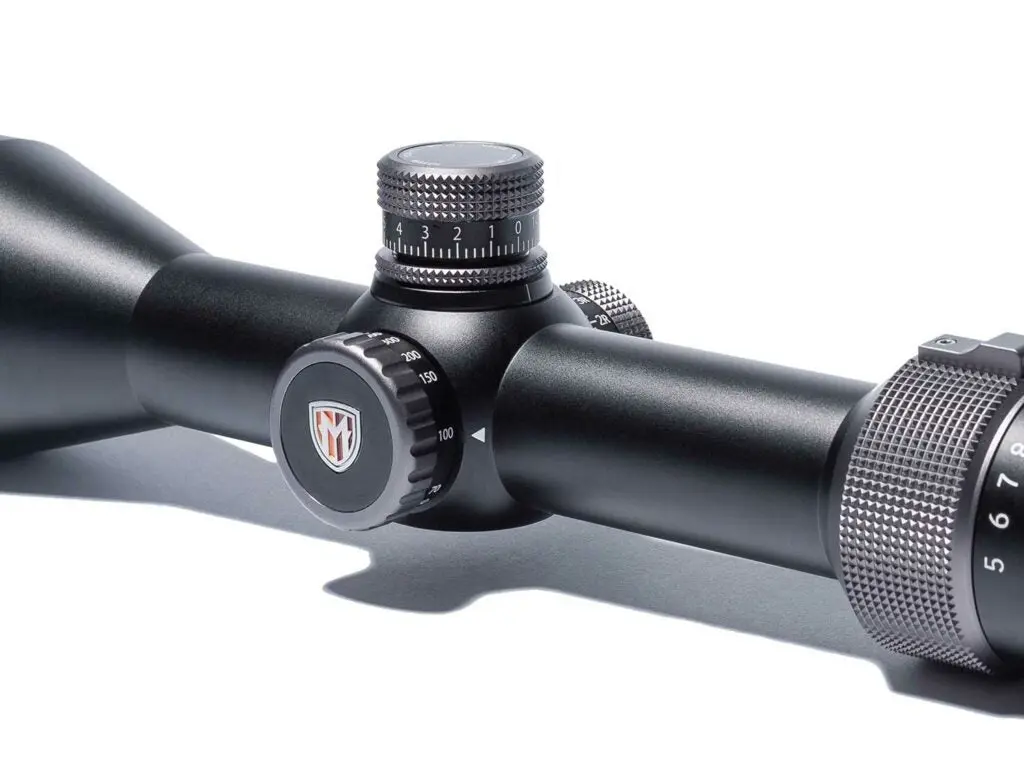
A side parallax adjustment knob. Maven Optics
If you’ve ever seen the reticle (or crosshairs) of your scope float around or come in and out of focus while on target, you’ve probably noticed the phenomenon of parallax. It happens when the reticle and the target are no longer on the same focal plane within the tube of the scope. The difference between focal planes becomes exaggerated at extremely close and far target distances—decreasing accuracy and obscuring the reticle. Some scopes allow you to manually adjust for this and bring everything into focus at different target distances while others are manufactured with a fixed parallax at a specific range.
Most centerfire scopes with fixed parallax are factory-focused around 150 to 175 yards—too far for common rimfire applications. Fixed parallax rimfire scopes are usually set at 50 or 60 yards, which can work fine for small-game hunting but makes 20- or 25-yard shots—common in many small-bore sports—a blurry mess. For any precision small-bore match scope, an adjustable parallax down to 25 yards is a must.
Most tactical-inspired and long-range centerfire scopes have a side knob for parallax adjustment, sometimes called “side focus.” Bench-shooting target scopes often have the parallax control built into the objective bell. This is called “Adjustable Objective” or AO. Side controls are easier to run when jumping between near and far targets within the same shot string. AO controls work fine when you have plenty of time.
Hunting recommendation: A 50-yard fixed parallax or adjustable parallax.
Match recommendation: An adjustable parallax, side focus or AO.
2. Focal Plane
When rifle scopes are manufactured, there are two locations within the tube where the reticle can be installed. If the reticle goes in toward the objective lens (the front of the tube), that’s called First Focal Plane (FFP). If it goes in near the ocular lens, or the back of the tube, that’s called Second Focal Plane (SFP). When dialing up the magnification on a FFP scope, the reticle will grow larger. In SFP scopes, the reticle will appear the same size no matter the magnification.
Many long-range shooters and long-range hunters have migrated to FFP scopes because reticle holdover values don’t change with the scope power. In other words, if every hash mark along the vertical stadia (the main crosshair line) represents 1 MOA at the lowest scope power, they still equal 1 MOA at the highest magnification on a FFP reticle, which is not the case for SFP reticles. This is a big advantage in some precision rimfire matches, where single-stage targets may jump from 20 to 100 yards or beyond, and the shooter may have to change scope magnification and holdover within the shot string. The drawback of FFP is that at very low scope power, the crosshairs can be too small—imperceptible even. This is why many hunters still prefer old-school SFP scopes. Even at low power, a shooter can clearly see the crosshairs and the target.
Hunting Recommendation: Second Focal Plane.
Match Recommendation: First Focal Plane.
3. Reticle Design
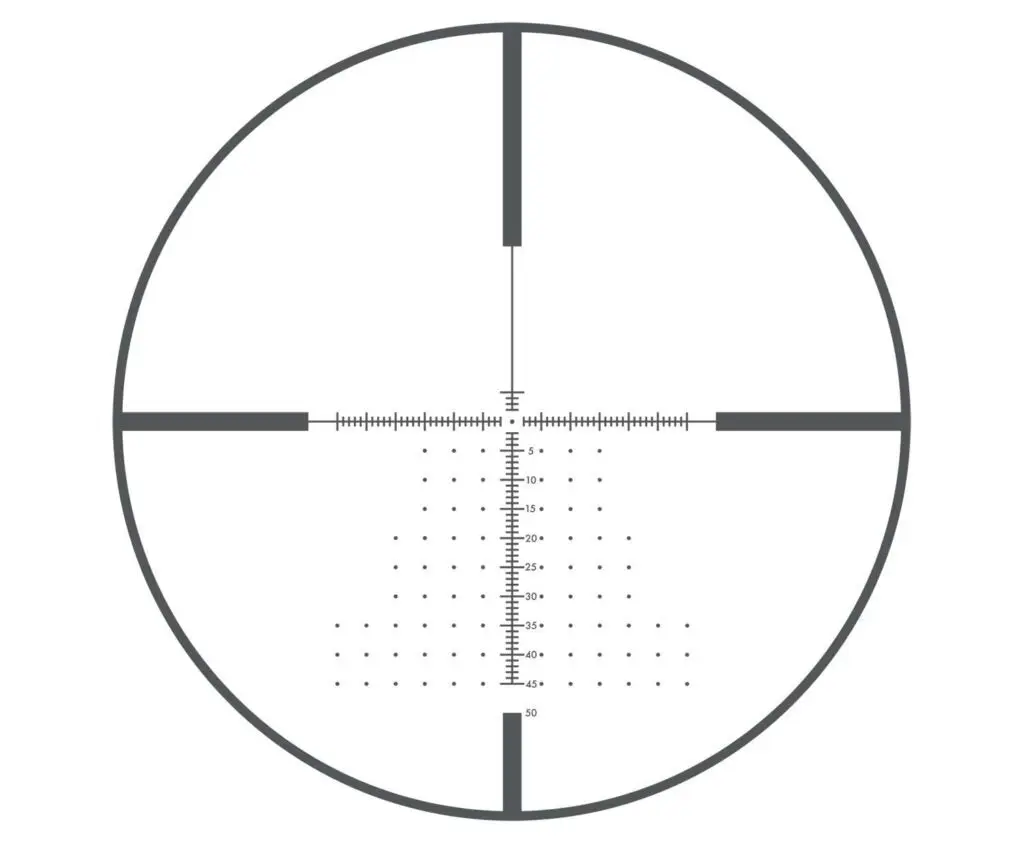
MOA hash marks on a Bushnell Forge reticle. Bushnell
In the last few years, no part of the rifle scope has been designed and redesigned more than the reticle, or aiming point. For hunting with laser-flat .17 calibers or .22 WMR, it’s hard to beat a simple duplex crosshair. Developed in the 1960s by Leopold, the duplex uses four heavy crosshair lines that taper down to fine lines where they meet in the center. This design makes placing the crosshairs on a target fast, and it always provides a clean sight picture.
When shooting slow rimfire loads, like .22 LR, bullet drop is more of an issue. For hunting work, .22 LR Ballistic Drop Compensating reticles (BDC) like those in the Nikon Prostaff Rimfire series, can work very well. These reticles have hash marks tuned to .22 LR ammo trajectories and indicate generally where the bullet will impact at longer ranges. With a little trial and error, they can provide hunters with solid hold-points from 25 yards out to 150 or more.
Competition reticles get very complicated very quickly. Rather than hash marks indicating likely .22 LR bullet holdovers, each line may represent a certain number of MOA or MILS (units of measure associated with target shooting). The finer these marks are, the more precise the measurement, theoretically. But too many marks can quickly clutter the sight picture, particularly for a shooter who’s spent his life shooting a duplex. This is especially the case with FFP scopes on low magnification, where a complicated reticle can look like smudged ink at low power. But, when lying prone 100 yards or more from your target, with match .22 LR ammo that drops like a brick—and flutters away in stout wind—all of a sudden, those hash marks become very handy. If you go for a complicated MOA or MILS reticle for your competition build, make sure to read the manual, and spend time practicing to really learn it.
Hunting recommendation: Duplex or BDC.
Match Recommendation: MOA or MILS
4. Turrets
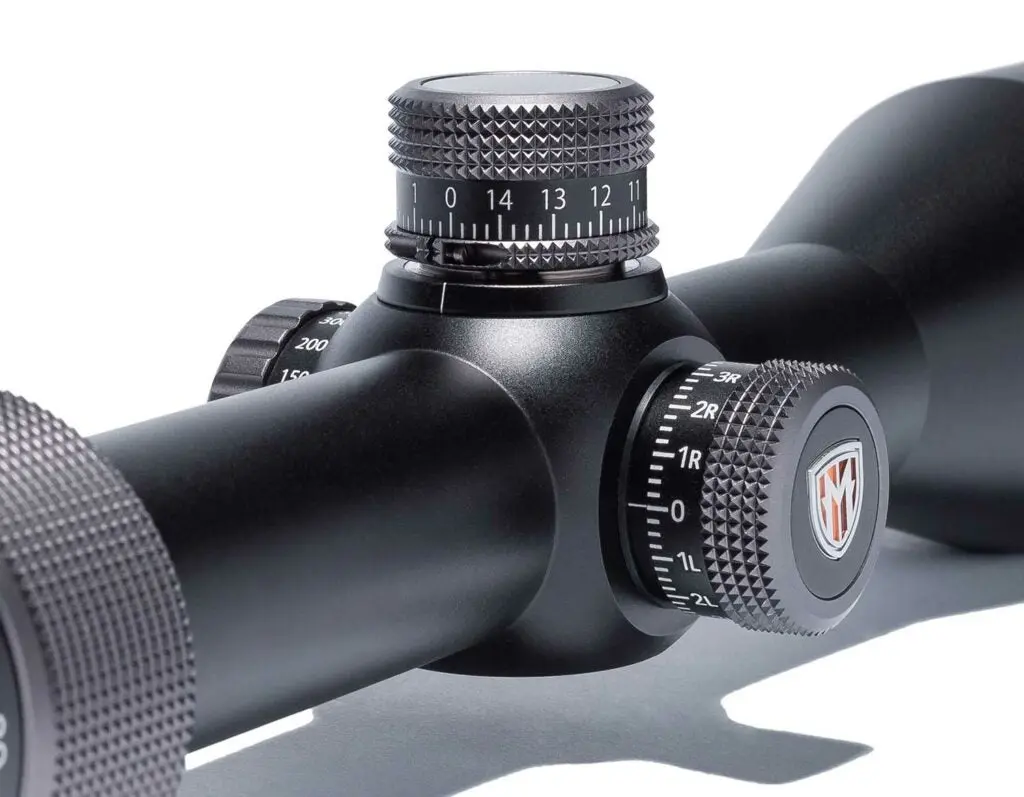
A Maven RS.3 with exposed adjustable turrets. Maven Optics
For the most part, there are two kinds of turrets available on rifle scopes. Either exposed turrets, which allow for manual adjustments in the field, or capped turrets that are usually adjusted once when zeroing a rifle, then left alone. Most NRL22 shooters use adjustable turrets.
For a .22 LR with a 50-yard zero, the center of the crosshairs is still an accurate hold from 20 to 60 yards or more, depending on ammo velocity. Push out beyond 60 or 70 yards, and the shooter has a decision to make: Use the hash marks on the reticle to hold over the target, or spin up the turret and hold center.
If a stage involves shooting a close target, at say 30 yards, then jumping to a 100-yard plate, most shooters just use the reticle. If target distances are fixed at 100 yards or more, dialing the turrets works great. For extended-distance rimfire shooting, like the developing sport of Rimfire ELR, or when clipping varmints a long way off, adjustable turrets are a must. Yet when you’re in the woods chasing squirrels or rabbits, turrets tend to just get in the way, and most of the shots you’ll take are within 60 yards.
Hunting recommendation: Capped turrets, unless varmint hunting.
Match recommendation: Exposed adjustable turrets.
5. Power
Magnification is great, and it’s the first thing many people consider when buying optics, but it’s probably the least important feature when actually hunting or competing with a rimfire. Sure, when shooting from a rock-solid rest at a tiny target a couple hundred yards away, 30X magnification is handy, but in most cases, it’s rare that anything more than 16X is required. Unless you’re going really long on a varmint hunt, magnification is even less important when hunting small game. Last September at our annual Kentucky squirrel camp, I used a 3X-9X scope and it stayed on 7X all week. My two hunting buddies liked a little more power, at 10X or 12X.
Hunting recommendation: 3X-9X or 4X-16X.
Match recommendation: 4X-16X to Hubble-level 27X, 30X, or 35X, as budget allows.
10 Rimfire Scopes for Hunting and Competition
Tract Optics 22 FIRE 3-9X40 BDC or T-Plex

Tract Optics 22 FIRE 3-9X40 BDC or T-Plex – MSRP $174 Tract Optics
In December 2015, two former Nikon employees started Tract Optics, a direct-to-consumer manufacturer, with the goal of providing better quality glass for the money by cutting out the middleman. Tract’s rimfire-specific 22 FIRE does just that. There’s a lot of value packed in for the money when compared to other .22 LR scopes on the market. The parallax on the 22 FIRE is fixed at 50 yards. The windage and elevation adjustments are ¼-inch at 50 yards with very good spring-loaded zero resets on both dials. The model I tested had highly repeatable adjustments with good, positive clicks. The 22 FIRE
is available with a T-Plex reticle or a BDC optimized for high-velocity ammo like CCI Stingers. Zero with Stingers or similar 1,400 to 1,600+ FPS loads at 50 yards with the BDC version, and the reticle’s dots show where to aim out to 150 yards in 25-yard increments. An accurate rifle, plus Stingers, plus the 22 FIRE adds up to a very deadly small-game setup.
Nikon Prostaff P3 Target EFR 3-9×40 AO

Nikon Prostaff P3 Target EFR 3-9×40 AO – MSRP $189 Nikon
Nikon recently told distributors that they’re getting out of the rifle scopes market
citing a crowded field. Bad news for rimfire shooters in the long-term, but in the short-term, it means there are some very good deals out there on remaining inventory. My favorite Nikon scope for rimfire shooting is the P3 Target EFR
, which has an AO parallax adjustment from 10 yards to infinity. The extra-fine target reticle has 1/8 MOA center dot, which is ideal for making very small groups off the bench at 50 yards with match ammo, or zeroing in on a single squirrel eyelash. I used this scope for a variety of small-game hunts over the last year, atop a Volquartsen Summit .17 Mach 2
, and it’s become my favorite precision bushytail rig.
Athlon Optics Argos BTR, 6-24×50

Athlon Optics Argos BTR, 6-24×50 – MSRP $379 Athlon Optics
Athlon Optics has quietly built a reputation for making quality, well-priced tactical scopes geared toward precision shooting. The Argos BTR
, which can be found for under $400 (and sometimes almost half that on sale), is a strong example. It’s one of the most popular base-class optics in NRL22
, where the combined rifle and scope MSRP can’t exceed $1,050. The scope is made of a 30mm tube with FFP guts; repeatable, positive MOA or MIL turrets; side focus from 10 yards to infinity; and an illuminated reticle. The 6-24×50 is their most popular competition configuration, but 8-34×56 and 10-40×56 models are available, too, if you’re looking for high-level magnification on a budget.
Vortex Optics Diamondback Tactical 6-24×50
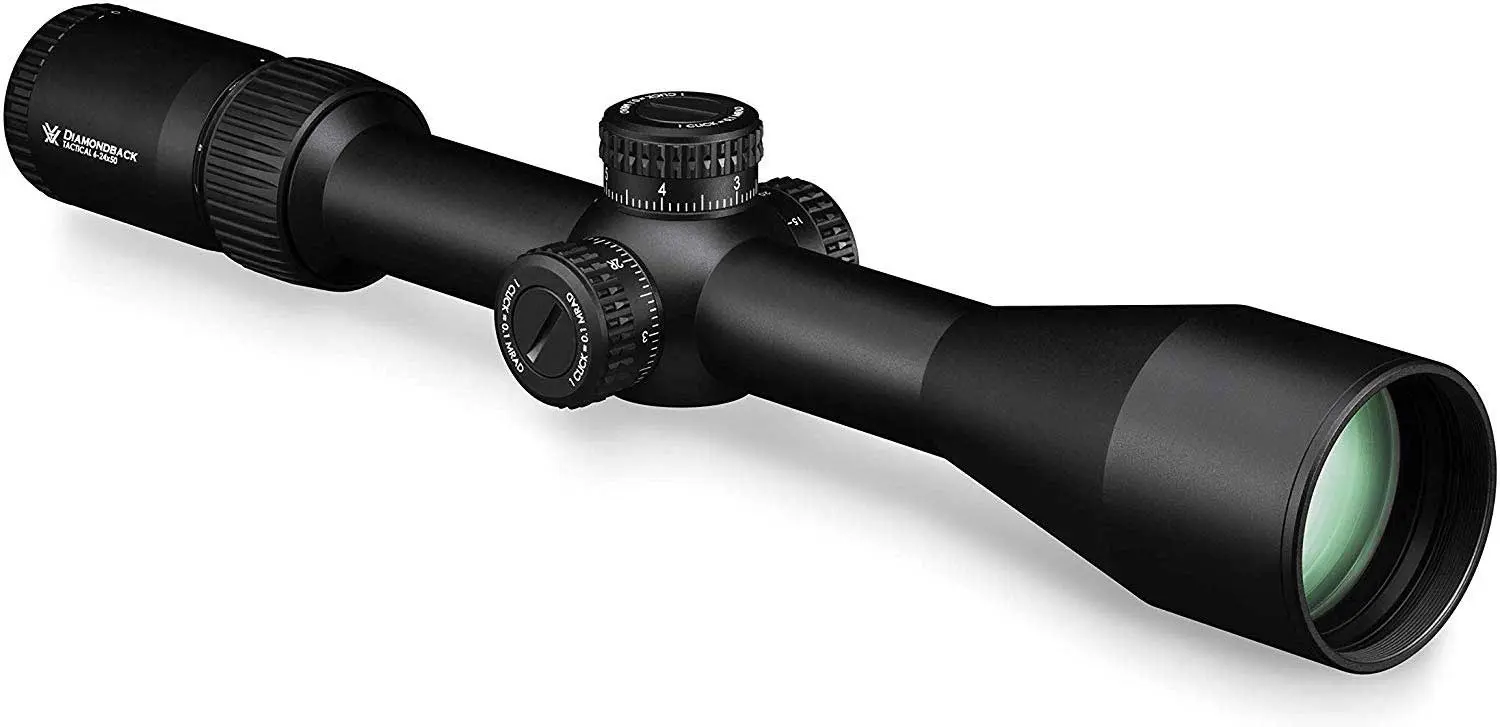
Vortex Optics Diamondback Tactical 6-24×50 – MSRP $399 Vortex
Another winning base-class NRL22 optic, the Diamondback Tactical
from Vortex has a cult following and comes with Vortex’s unlimited, unconditional, no-questions-asked lifetime warranty. I’ve put this scope on a Ruger American Rimfire in .22 LR as a base-class NRL22 rig, and it makes for an accurate, repeatable, and affordable precision rimfire package. This FFP optic is available with MRAD or MOA turrets and reticles, it has 19 mils or 65 MOA of adjustment in windage and elevation—more than similar scopes in this price range—along with a wider field of view than its peers. I’ve come to really like the intuitive EBR-2C (MRAD) reticle, too, which packs a lot of information into a clean sight picture.
Leupold VX-3i 4.5-14×40 Side Focus Duplex
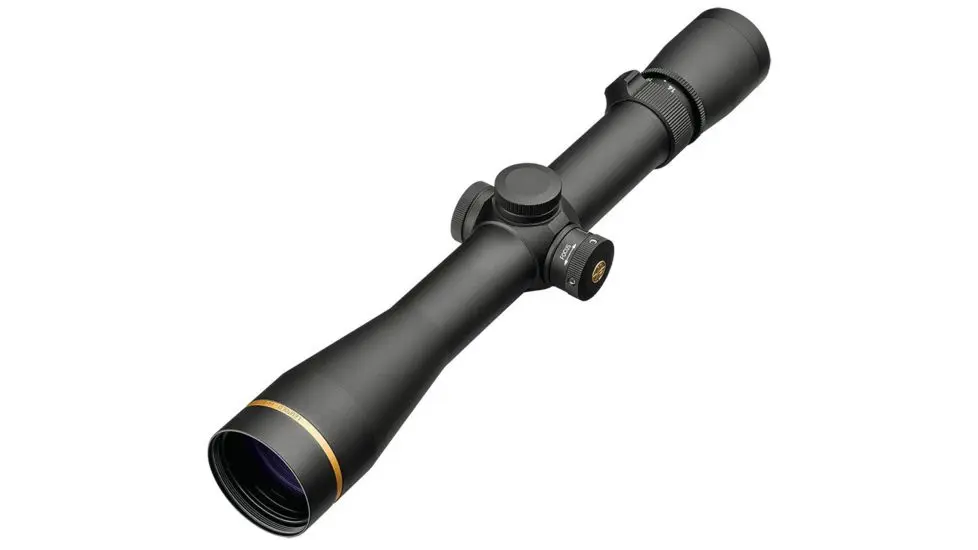
Leupold VX-3i 4.5-14×40 Side Focus Duplex – MSRP $779 Leupold
No one can argue with the clarity and versatility of Leupold’s VX-3 lineup
. Of them all, the compact 4.5-14×40 with side focus is ideal for a long-range squirrel sniping setup. Unlike more tactical scopes listed here, this Leupold is defined by its slender profile. It weighs a mere 15.3 ounces, but packs a lot of magnification into that light package. Make no mistake, this is a centerfire scope happily at home on a .300 WSM, but the form factor, side focus, and killer Leupold low-light clarity makes it ideal for a long-range rimfire hunter, too.
Bushnell Forge 4.5-27×50 SFP Deploy MOA
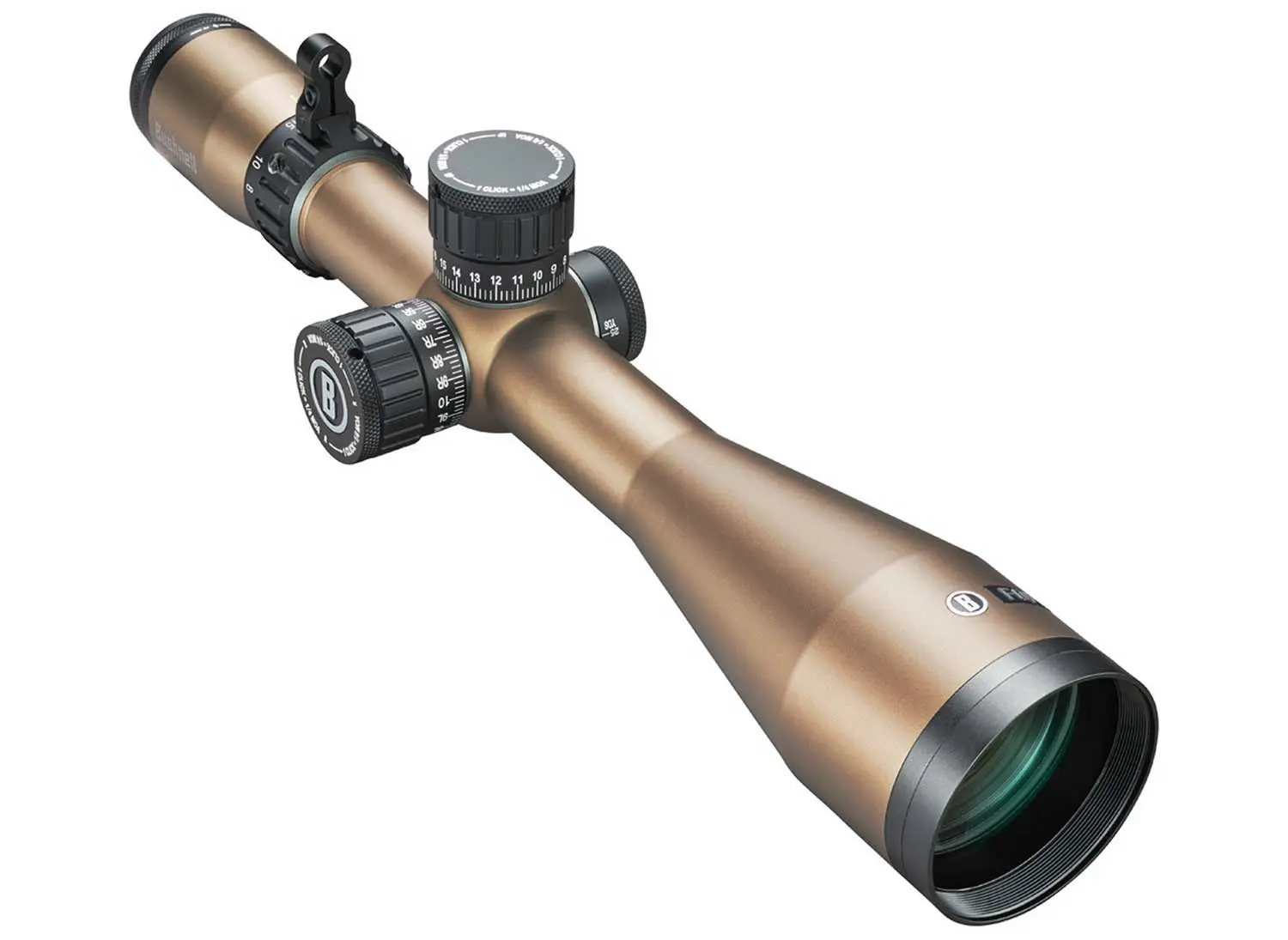
Bushnell Forge 4.5-27×50 SFP Deploy MOA – MSRP $879-$949 Bushnell
For a reach-out-and-touch-them rimfire rifle built for varmint hunting or very long target work, it’s hard to beat this big scope from Bushnell
. The FFP version runs almost $1,000, but you can pick up the SFP model for around $500 with a little Internet sleuthing. Bushnell’s Deploy reticle is among the simplest of the hash-mark-heavy options out there, and 4.5- to 27-power provides ridiculous versatility, whether plinking at long-range or cleaning up prairie dogs. This scope was my first choice for a Savage A17 build
. With a 50-yard zero, I can spin up 18 MOA of elevation for a dead-nuts hold at 360 yards—a long, but plausible shot with 17 HMR. It’s a fun combination with steel downrange at 300 and 400 yards.
Athlon Optics Ares ETR 4.5-30×56

Athlon Optics Ares ETR 4.5-30×56 – MSRP $1,199 Athlon Optics
. There are no two ways about it. It weighs 2.2 pounds, and the 30mm tube is more than 15 inches long with big exposed locking turrets and a 56mm bell. For a pure precision match rifle, where more weight is generally better, the Ares ETR shines. The 30x magnification makes 100-yard steel gongs look gigantic. The illuminated APRS1 reticle shows 6 MILS of drop at 30X, and the full 10 MILS at 16X—the magnification power I tend to run most in matches. This means on a course of fire that has me jumping between various target distances, I can keep the power at 16X, use the 25-yard to infinity side focus to pick up targets clearly from 20 yards to 100, then make the shots using the corresponding hashmark in the reticle for those distances. With a 25 MOA pic rail
under the scope, plus Burris XTR Signature Rings
with another 5 MOA drop, this scope can zero my match ammo at 50 yards, then provide a ridiculous 24 MILS of come-ups in the turret, for an accurate hold out to 420 yards.
Maven RS.1 2.5-15×44

Maven RS.1 2.5-15×44 – MSRP $1200 Maven
The 6X multiplier in this Maven scope
allows for more magnification in a smaller package, or six times the power at the top end from the low end. All of a sudden, a scope that’s the same size as a traditional 2.5X-10X jumps to 2.5X-15X. These scopes command serious money, but they bring a very attractive do-it-all quality to a rifle build.
The RS.1 is perfect for hunting. The 44mm bell gathers more than enough light for clear shots a half-hour before sunrise and after sunset. The windage and elevation dials are capped—they’re not exposed turrets like tactical scopes—so even if they do snag on shrubs or trees in the woods, you don’t have to worry about your point of impact changing. The side focus runs 10 yards to infinity and the clean SFP reticle means even at 2.5X you can find your crosshairs easily, which can’t be said for all FFP scopes with such low magnification. For close shots at squirrels, you have that 2.5X low end. For 80-plus-yard headshots, you get a crystal clear top end at 15X. That’s a kind of versatility that’s hard to beat. You’ll pay for it, but it’s worth it.
Maven RS.3 5-30×50

Maven RS.3 5-30×50 – MSRP $1600 Maven
If you like the RS.1 but you want more power or tactical-inspired adjustable turrets, then the RS.3
is what you want. It has that 6X multiplier Maven does so well, but in a long 5X-30X magnification range. Even with the 30mm tube and 50mm objective, it doesn’t feel too big. Maven looped in several expert Western long-range hunting experts in the design and it shows.
Nightforce ATACR 7-35×56 F1

Nightforce ATACR 7-35×56 F1 – MSRP $4000 Nightforce
If you want the very best in a long-range precision optic, budget be damned, then this is your scope. At the NRL22 Nationals in Las Vegas last May, 11 of the 60 shooters that filled out an after-match gear survey topped their rifle with a Nightforce ATACR
. Five of the top seven open-class winners all ran this scope, including first and second place. Paired with a Vudoo rifle, it was by far the winningest rifle/scope combination in the event. Sure, a $4,000 scope (on a $4,000 .22 LR rifle) isn’t for everyone, but if you want the cream of the precision-rimfire crop, this is it.






